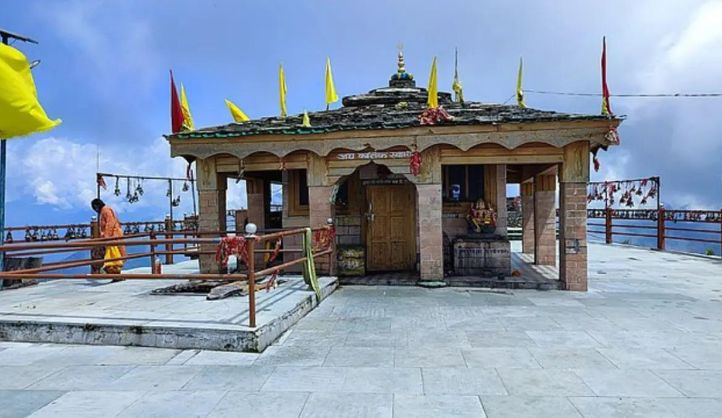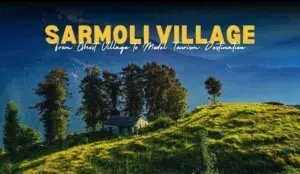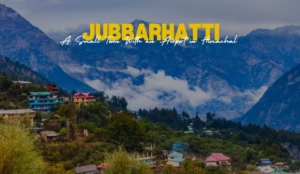Introduction
Nestled amidst the breathtaking Himalayan ranges, the Kartik Swami Temple stands as a symbol of devotion, serenity, and natural beauty. This hidden gem offers a spiritual haven for pilgrims and adventure enthusiasts alike. Let’s embark on a journey to discover the allure of Kartik Swami Temple.
Unveiling the Legends
Kartik Swami, nestled amidst the awe-inspiring Himalayan ranges, is a sanctuary of spirituality with legends that resonate through the ages. These tales, interwoven with mythology and history, bring forth the essence of the temple’s significance:
- The Birth of Kartikeya: The temple’s central legend revolves around Lord Kartikeya, the son of Lord Shiva and Goddess Parvati. It is believed that Lord Kartikeya chose this very spot as his abode, bestowing it with divine energy.
- Kartikeya’s Penance: According to the lore, Kartikeya embarked on an arduous penance at this site to attain supreme powers. His intense meditation was a demonstration of his determination and spiritual dedication.
- A Battle against Demons: Another tale speaks of Kartikeya’s valiant battle against the demon armies that threatened the world. His victory in this cosmic confrontation symbolizes the triumph of good over evil.
- The Sage and the Temple: A sage named Adi Shankaracharya, revered for his philosophical wisdom, is said to have established the temple in reverence to Lord Kartikeya. He recognized the sanctity of the location and its potential to enhance spiritual growth.
- Kartik Poornima: The temple gains special significance during the Kartik Poornima festival, which celebrates the full moon in the Kartik month of the Hindu calendar. Devotees from far and wide gather to seek the blessings of Kartikeya and partake in the festivities.
- Echoes of Eternal Love: The legends also portray the enduring bond between Lord Shiva and his son Kartikeya. The temple becomes a symbol of their eternal relationship and the guidance passed down through generations.
- The Whispering Breeze: Local tales talk of the breeze that gently rustles through the temple’s surroundings. It is said to carry the whispered blessings of Kartikeya, filling the air with divine tranquility.
- The Pilgrims’ Path: Over time, the temple’s legends have drawn countless pilgrims who seek to connect with the spiritual energy of the place. Each step on the pilgrimage path echoes the footsteps of devotees who’ve walked this journey before.
- A Portal to Enlightenment: The legends depict Kartik Swami as a portal to spiritual enlightenment, where seekers can shed their worldly concerns and embark on a transformative journey towards self-discovery.
- Guardian of the Himalayas: Kartik Swami is often considered a guardian deity of the Himalayan region, bestowing protection upon those who traverse its rugged terrain and offering solace to weary travelers.
- Awe-Inspiring Panorama: The legends become even more vivid against the backdrop of the breathtaking Himalayan panorama visible from the temple’s vantage point. The scenic beauty mirrors the divine grandeur of the tales themselves.
- A Living Narrative: As pilgrims gather at Kartik Swami, the legends come alive in the shared stories and experiences they exchange. These narratives weave together a tapestry of devotion, history, and spirituality.
Best Time to Visit Kartik Swami Temple
Selecting the right time for your pilgrimage to Kartik Swami Temple can significantly enhance your experience, allowing you to fully immerse yourself in its spiritual aura and natural beauty. The optimal times for your visit are as follows:
- Spring (April to June): The spring season ushers in mild weather, making it an ideal time to embark on the trek to Kartik Swami Temple. The surrounding landscape comes to life with blooming flowers and vibrant foliage, enhancing the visual appeal of the journey. The temperatures are pleasant during the daytime, and the trekking paths are usually clear of snow, making it easier to access the temple.
- Autumn (September to November): Another favorable period is autumn, when the monsoon rains have subsided, leaving behind lush greenery and clear skies. The temperatures are comfortable, creating favorable conditions for both the journey and the temple visit. The panoramic views from the temple’s vantage point are particularly stunning during this season.
- Kartik Poornima Festival: The Kartik Poornima festival, which usually falls in November, is a highly auspicious time to visit the temple. During this time, the temple witnesses an influx of pilgrims who gather to celebrate and seek the blessings of Lord Kartikeya. The festive atmosphere and cultural activities add an extra layer of significance to your visit.
- Avoid Monsoon (July to August): Monsoon brings heavy rainfall and increased chances of landslides, making the trekking paths slippery and potentially hazardous. It’s advisable to avoid visiting Kartik Swami Temple during these months to ensure your safety and the quality of your pilgrimage experience.
- Winter (December to February): While the winter months offer a unique charm with snow-covered landscapes, the temperatures can drop significantly, especially in higher altitudes. The trek might be challenging due to cold weather and the possibility of snow blocking the paths. However, if you’re well-prepared for the cold and seek a more secluded experience, winter could be an option.
Remember to check the weather forecast and local conditions before planning your trip. It’s also a good idea to consult local authorities or guides to ensure that the trekking paths are safe and accessible.
The Journey to Tranquility
The voyage towards Kartik Swami Temple is not merely a physical trek but a transformative odyssey that leads to the embrace of unparalleled tranquility. This sacred pilgrimage unfolds through a series of stages, each contributing to the profound sense of serenity experienced at the temple’s culmination:
- Embarking on the Path: The journey commences with the first step taken amidst the verdant Himalayan landscape. As pilgrims tread the meandering trails, the bustling of daily life gradually fades, making way for a quieter, more introspective mindset.
- Nature’s Embrace: Enveloped by lush forests, gurgling streams, and chirping birds, travelers are embraced by the unspoiled beauty of nature. The symphony of the elements becomes a soothing balm, easing the weariness of the journey and inviting contemplation.
- Elevation of Perspective: The ascent brings a change in perspective, both physically and spiritually. As the altitude increases, so does the pilgrim’s consciousness, shedding the trivial concerns of everyday life and focusing on the profound.
- The Whispers of Wind: Amidst the towering trees and undulating landscape, the wind carries with it a subtle message of ancient wisdom. Its whispers seem to convey the tales of pilgrims who’ve walked this path for generations, fostering a sense of connection with the past.
- Echoes of Silence: The deeper one ventures into the heart of the mountains, the more pronounced the silence becomes. This silence is not void but a canvas for introspection, allowing pilgrims to hear the echoes of their own thoughts and inner stirrings.
- Contemplative Rhythms: The rhythmic pattern of footsteps on the trail synchronizes with the rhythm of the pilgrim’s heartbeat. This natural harmony aids in turning inward, facilitating a meditative state even while in motion.
- Meeting Fellow Travelers: Along the way, chance encounters with fellow travelers weave a tapestry of shared experiences. Conversations unfold like chapters of a collective spiritual journey, fostering camaraderie and mutual support.
- Ascending Faith: As the temple nears, the terrain may grow steeper, testing the pilgrim’s endurance. Yet, this challenging ascent mirrors the ascent of faith, where determination overcomes obstacles, mirroring the journey toward spiritual enlightenment.
- Panorama of Revelation: Upon reaching Kartik Swami Temple’s summit, a breathtaking panorama of snow-clad peaks and verdant valleys reveals itself. This expansive view symbolizes the grandeur of the spiritual journey and the broader perspective it brings.
- Sanctuary of Serenity: Within the temple’s precincts, profound tranquility envelops the devotee. The centuries-old stone walls seem to exude the accumulated reverence of countless pilgrims, inviting a deep sense of inner calm.
- Divine Connection: In the presence of Lord Kartikeya, pilgrims find a tangible connection with the divine. The deity’s serene countenance radiates an aura of peace and grace, leaving a lasting impression on the hearts of devotees.
- Wholeness and Renewal: The descent from Kartik Swami is marked by a sense of wholeness and renewal. Pilgrims carry with them the echoes of the temple’s spiritual energy, which continue to resonate within, even as they return to the world below.
Architectural Marvel and Panoramic Views
The Kartik Swami Temple is not only a spiritual destination but also an architectural marvel that offers breathtaking panoramic views. Situated in the Garhwal region of Uttarakhand, India, this temple is renowned for its serene beauty and stunning surroundings.
The temple’s architecture is a blend of traditional design and modern construction techniques. Its intricately carved wooden pillars, ornate doorways, and beautifully crafted idols showcase the skill and dedication of the artisans who created this masterpiece. The use of local materials adds a touch of authenticity to the structure, making it a true representation of the region’s architectural heritage.
What truly sets the Kartik Swami Temple apart, however, is its spectacular location. Perched atop a hill at an altitude of around 3050 meters (10,006 feet), the temple offers panoramic views of the surrounding Himalayan peaks, lush valleys, and the winding Ganges River. As you stand before the temple or take a leisurely stroll around its premises, you’re treated to a mesmerizing 360-degree vista that seems almost surreal.
The sight of the sun rising and setting behind the snow-capped mountains is an experience that words can hardly describe. The panoramic views extend in every direction, giving visitors a sense of awe and wonder at the grandeur of nature. The serenity of the environment, combined with the spiritual ambiance of the temple, makes Kartik Swami a perfect place for introspection and inner peace.
Whether you’re a devout pilgrim, an architecture enthusiast, or simply someone seeking a retreat from the bustling world, the Kartik Swami Temple offers an unforgettable experience. Its architectural beauty and breathtaking panoramic views make it a place that leaves an indelible mark on your heart and soul.
Embracing the Spiritual Vibe
Embracing the Spiritual Vibe of Kartik Swami:
- The serenity of the Himalayas: Kartik Swami is situated in the picturesque Himalayan region, offering a serene and tranquil environment that naturally fosters a spiritual vibe.
- Sacred Legend: The temple is associated with Lord Kartikeya, the son of Lord Shiva, and has a rich mythological and historical significance that adds to its spiritual aura.
- Majestic Trek: The journey to Kartik Swami involves a trek through lush forests, gushing streams, and breathtaking landscapes. This trek itself is often considered a spiritual experience, allowing pilgrims to connect with nature and their inner selves.
- Solitude and Introspection: The remote location of the temple provides a perfect setting for solitude and introspection. Away from the noise of modern life, pilgrims can delve deep into their thoughts and emotions.
- Panoramic Views: Once you reach the temple, you’re rewarded with panoramic views of the surrounding Himalayan peaks and valleys. This grandeur of nature can evoke a sense of awe and trigger spiritual contemplation.
- Meditative Practices: Many visitors engage in meditation and yoga at Kartik Swami to enhance their spiritual connection. The tranquility of the surroundings makes it an ideal place for such practices.
- Devotional Atmosphere: The atmosphere around the temple is infused with devotion and reverence. Pilgrims come to offer prayers, perform rituals, and seek blessings, creating an energy of spiritual devotion.
- Austerity and Endurance: The physical effort required to reach Kartik Swami can symbolize an act of austerity and endurance. This challenges pilgrims to push their limits, leading to personal growth and a stronger connection with their spiritual selves.
- Community of Pilgrims: The presence of fellow pilgrims fosters a sense of community and a shared spiritual journey. Interactions with like-minded individuals can deepen one’s understanding of spirituality.
- Vibrant Festivals: During festivals dedicated to Lord Kartikeya, such as Kartik Poornima, the temple comes alive with vibrant celebrations, hymns, and rituals. Participating in these festivities can evoke a sense of unity and spiritual fervor.
- Storytelling and Wisdom: Elders often narrate stories and legends related to the temple, passing down wisdom and spiritual teachings. These stories serve as a medium to transmit values and inspire spiritual growth.
- Detachment from Materialism: The simplicity of life around Kartik Swami encourages pilgrims to detach from materialistic desires and focus on the essence of spirituality.
- Renewed Perspective: The spiritual vibe of Kartik Swami can lead to a renewed perspective on life. Pilgrims may gain insight into their purpose, values, and the interconnectedness of all beings.
- Elevation of Consciousness: The combination of natural beauty, devotion, and introspection can lead to an elevated state of consciousness. This heightened awareness often accompanies profound spiritual experiences.
- Eternal Connection: Many believe that visiting Kartik Swami helps establish an eternal connection with the divine. The memories and insights gained during the journey remain with pilgrims long after they leave.
In essence, Kartik Swami’s spiritual vibe is a culmination of its natural beauty, ancient legends, devotion, introspection, and the transformative journey it offers. It’s a place where one can disconnect from the mundane and connect with the spiritual essence that resides within and around us.
Conclusion
The Kartik Swami Temple is not just a place of worship; it’s a sanctuary of tranquility, a testament to nature’s grandeur, and a repository of ancient legends. This hidden gem in the Himalayas holds the power to captivate hearts, nurture spirituality, and provide an unforgettable journey for every soul that ventures here.
FAQs
1. Can I drive to Kartik Swami Temple? No, the temple can only be reached by trekking, adding to its adventure and charm.
2. Is photography allowed inside the temple premises? Yes, photography is allowed, but it’s recommended to respect the sanctity of the temple while taking pictures.
3. Are there any accommodation options near the temple? While there are limited accommodation options, many visitors prefer staying at Kanakchauri village before embarking on the trek.
4. Is the temple accessible throughout the year? The temple remains open for most of the year, except during heavy snowfall in the winter months.
5. Are there any medical facilities on the trekking route? It’s advisable to carry basic medical supplies, and there are also small medical facilities available in Kanakchauri village.





